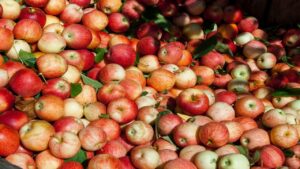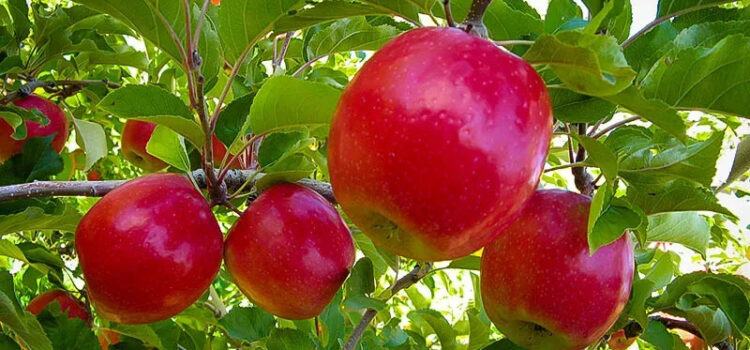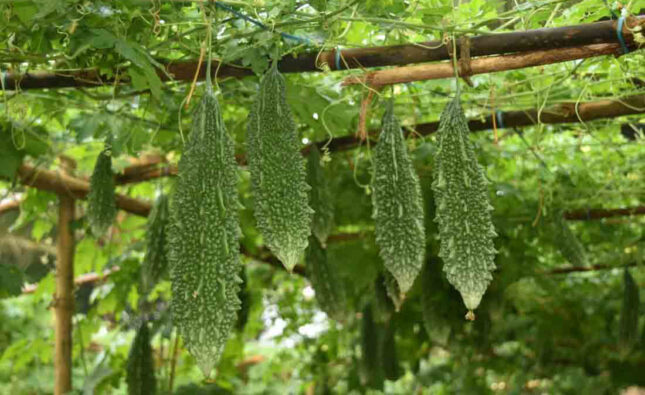Cultivation Of Apple, Its Verities, Market Demand and Sells
The apple is a popular fruit that is widely recognized and consumed around the world. It is a pomaceous fruit, meaning it belongs to the botanical family Rosaceae and the genus Malus. Apples are known for their round shape, typically with a slightly tapered bottom and a stem at the top. Apples come in various colors, including shades of red, green, and yellow. The skin of an apple is generally thin and edible, while the flesh inside is crisp and juicy. The flavor and texture can vary depending on the apple variety, ranging from sweet to tart and from soft to firm. Apples are highly nutritious and are a good source of dietary fiber, vitamin C, and various antioxidants. They are also low in calories and fat, making them a healthy snack option. Apples are often eaten fresh but can also be used in cooking and baking, such as in pies, sauces, and juices. There are numerous apple varieties cultivated worldwide, each with its own characteristics in terms of taste, texture, and color. Some popular apple varieties include Granny Smith, Gala, Fuji, Golden Delicious, Red Delicious, and Honeycrisp, among many others.
Cultivation Of Apple
The cultivation of apples involves several stages, from selecting the right apple variety to planting, caring for the trees, and harvesting the fruit. Here is a general overview of the cultivation process:
1. Variety selection:
Choose an apple variety that is well-suited to your climate, soil type, and intended use (fresh consumption, cooking, cider, etc.). Consider factors such as disease resistance, chilling requirements, and pollination compatibility. There are numerous varieties of apples grown worldwide, each with its own unique characteristics in terms of taste, texture, color, and maturity time. Here are some popular apple varieties:
-
Granny Smith:
Known for its bright green skin and tart flavor, Granny Smith apples are crisp and firm. They are often used in baking, salads, and for making apple sauces.

-
Gala:
Gala apples have a thin, red-orange skin with yellow undertones. They have a sweet flavor and a crisp, juicy texture. Gala apples are great for eating fresh and are also used in salads and baking.
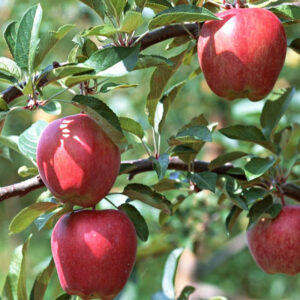
-
Fuji: Fuji
apples originated in Japan and are known for their sweet and crisp flesh. They have a yellow-green skin with red blush or stripes. Fuji apples are excellent for eating fresh and can also be used in baking.

-
Golden Delicious:
These apples have a yellowish-green skin and a sweet, mild flavor. They have a tender, crisp flesh and are versatile for both eating fresh and cooking.
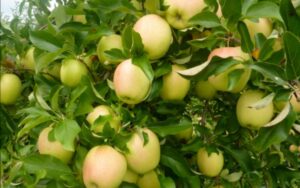
-
Red Delicious:
Red Delicious apples have a distinctive elongated shape and a bright red skin. They have a mildly sweet flavor and a crunchy texture. While they are often enjoyed fresh, they are less suitable for cooking.

- Honeycrisp:
Honeycrisp apples are highly sought after for their exceptional crunchiness, juiciness, and sweet-tart flavor. They have a red and yellow skin and are great for eating fresh or in salads.

- Pink Lady:
Also known as Cripps Pink, Pink Lady apples have a distinctive pinkish-red skin and a tangy-sweet flavor. They are crisp and juicy and work well for eating fresh, baking, and making cider.
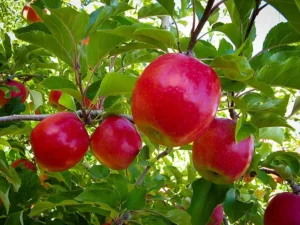
- Braeburn:
Braeburn apples have a red and green skin with a sweet-tart flavor. They have a crisp texture and are suitable for eating fresh, baking, and cooking.
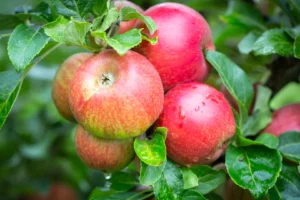
- Jonagold:
Jonagold apples are a cross between Jonathan and Golden Delicious varieties. They have a red-orange skin with yellow-green stripes and a sweet-tart flavor. They are versatile for eating fresh, baking, and cooking.

- Cortland:
Cortland apples have a bright red skin with occasional green patches. They have a mildly tart flavor and a tender, juicy flesh. Cortland apples are often used in salads, pies, and sauces.

These are just a few examples of the many apple varieties available. The specific varieties grown in an area can vary depending on the climate, local preferences, and market demands.
2. Site selection & Soil:
Select a site with good soil drainage, full sun exposure (at least 6 hours of direct sunlight per day), and protection from strong winds. Conduct a soil test to ensure the soil pH and nutrient levels are appropriate for apple cultivation. Apples grow best on a well-drained, loam soils having a depth of 45 cm and a pH range of pH 5.5-6.5. The soil should be free from hard substrata and water-logged conditions. Soils with heavy clay or compact subsoil are to be avoided.
3. Propagation
-
Grafting:
Apples are propagated by several methods viz.; whip, tongue, cleft and roots grafting. Tongue and cleft grafting at 10-15 cm above the collar during February-March gives the best results. Usually grafting is done at the end of winter.
-
Budding:
Apples are mostly propagated by shield budding, which gives a high percentage of success. In shield budding a single bud along with a shield piece of stem is cut along with the scion and inserted beneath the rind of the rootstock through a ‘T’ shaped incision during active growth period. Budding is done when the buds are fully formed during summer. The optimum time of budding is September in Kashmir Valley, Kumaon hills of Uttaranchal, high hills of Himachal Pradesh and June in mid hills of Himachal Pradesh.
-
Rootstocks:
Most of the apple plants are grafted or budded on seedling of wild crab apple. The seedling rootstocks obtained from the seeds of diploid cultivars like Golden Delicious, Yellow Newton, Wealthy, Macintosh and Granny Smith also can be used. High density planting is done using dwarfing rootstocks (M9, M4, M7 and M106).
4. Growing Period of Apple Tree
Planting is usually done in the month of January and February. Pits measuring 60 cm are dug two weeks before planting. The pits are filled with good loamy soil and organic matter. Planting is done in the centre of the pit by scooping the soil and placing the soil ball keeping the roots intact. Loose soil is filled up in the remaining area and lightly pressed to remove air gaps. The seedlings are staked and watered immediately.
5. Planting:
Plant apple trees in early spring or late fall. Dig a hole wide and deep enough to accommodate the tree’s root system. Place the tree in the hole, ensuring that the graft union (the swollen area where the scion is attached to the rootstock) is above ground level. Backfill the hole with soil, firming it gently around the roots.
6. Tree care:
Provide regular watering, especially during dry periods, to keep the soil evenly moist. Apply organic mulch around the base of the tree to conserve moisture and suppress weeds. Prune the trees annually to promote healthy growth, remove dead or diseased wood, and shape the tree.
7. Manuring & Fertilization:
Apply fertilizers based on soil test recommendations to ensure adequate nutrient supply. Nitrogen, phosphorus, and potassium are the primary macronutrients needed by apple trees, but they also require trace elements such as iron, zinc, and boron. There are recommended doses of manure & fertilizers as following.
Farmyard manure @ 10 kg./ year age of tree is applied along with other fertilizers. The fertilizer dose depends upon the fertility of soil and amount of organic manure applied to the crop. Generally, application of 350 g N, 175 g P2O5 and 350 g K2O per plant per year in split doses is recommended for fully-grown bearing trees. On some trees deficiency of zinc, boron, manganese and calcium may be observed which is corrected with the application of appropriate chemicals through foliage spray.
8. Pest and disease management:
Monitor the trees regularly for pests such as apple maggots, aphids, codling moths, and diseases like apple scab, powdery mildew, and fire blight. Implement integrated pest management (IPM) strategies, which may include cultural practices, biological controls, and judicious use of pesticides when necessary. The information to control disease in apple fruits described in details in the session of diseases management bellow.
9. Thinning and pruning:
Thin the developing fruit during the growing season to improve fruit size and quality. Prune the trees in late winter or early spring to maintain an open canopy, promote airflow, and facilitate sunlight penetration.
10. Harvesting:
Apples are typically harvested when they reach maturity, which varies depending on the variety. Mature apples should have developed their characteristic color, have a firm texture, and easily detach from the tree when gently twisted. Harvest carefully to avoid bruising the fruit.
Nutrient Value of Apple
Apples are a nutritious fruit that provides several essential nutrients. Here is an overview of the nutrient value of an average-sized apple (approximately 100 grams):
- Calories: Around 52 calories
- Carbohydrates: Approximately 14 grams
- Dietary Fiber: Roughly 2.4 grams
- Vitamin C: Provides about 8% of the recommended daily intake
- Potassium: Contains around 107 milligrams
- Vitamin K: Provides a small amount, approximately 2% of the recommended daily intake
- Antioxidants: Apples are rich in antioxidants, including flavonoids and polyphenols, which help combat oxidative stress and inflammation in the body.
The specific nutrient content can vary slightly depending on the variety and size of the apple. The dietary fiber in apples, particularly in the form of pectin, can contribute to feelings of fullness and aid in digestion. Additionally, apples are a low-calorie and fat-free fruit, making them a healthy snack option.

Health Benefits of Apple
Apples offer a range of health benefits due to their nutrient content and various bioactive compounds. Here are some of the potential health benefits associated with consuming apples:
1. Nutrient-rich:
Apples are a good source of dietary fiber, vitamin C, potassium, and antioxidants. These nutrients support overall health and well-being.
2. Heart health:
The soluble fiber found in apples, mainly in the form of pectin, may help lower cholesterol levels and reduce the risk of heart disease. Apples also contain flavonoids, which have been associated with a decreased risk of cardiovascular disease.
3. Digestive health:
The fiber content in apples can aid in maintaining a healthy digestive system by promoting regular bowel movements and preventing constipation. The pectin in apples acts as a prebiotic, supporting the growth of beneficial gut bacteria.
4. Blood sugar control:
The fiber in apples can help regulate blood sugar levels by slowing down the digestion and absorption of carbohydrates. This can be beneficial for individuals with diabetes or those at risk of developing diabetes.
5. Weight management:
Apples are relatively low in calories and high in fiber, making them a filling and satisfying snack. Including apples as part of a balanced diet can help with weight management by promoting feelings of fullness and reducing overall calorie intake.
6. Antioxidant activity:
Apples contain various antioxidants, including flavonoids and polyphenols. These compounds have been linked to reducing oxidative stress, inflammation, and the risk of chronic diseases, such as certain types of cancer and neurodegenerative disorders.
7. Hydration:
Apples have high water content, which can contribute to maintaining proper hydration levels in the body.
8. Oral health:
Chewing apples stimulates saliva production, which helps reduce the risk of tooth decay and promotes oral health.
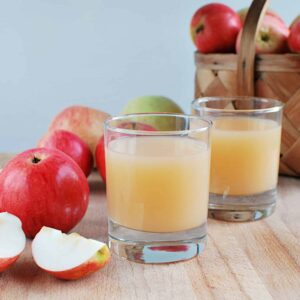
Diseases in Apple Fruits
Apples can be susceptible to various diseases, which can affect the health and productivity of the trees as well as the quality of the fruit. Here are some common diseases that can affect apple fruits:
1. Apple Scab (Venturia inaequalis):
Apple scab is a fungal disease that causes dark, scaly lesions on the fruit, leaves, and twigs. It can lead to reduced fruit quality and yield if left untreated.
2. Fire Blight (Erwinia amylovora):
Fire blight is a bacterial disease that can cause blackened and withered blossoms, shoots, and fruit. It can spread rapidly and cause severe damage to apple trees.
3. Cedar Apple Rust (Gymnosporangium juniperi-virginianae):
Cedar apple rust is a fungal disease that typically requires both apple trees and nearby juniper trees for its life cycle. It can cause yellow-orange lesions on the fruit and leaves.
4. Apple Powdery Mildew (Podosphaera leucotricha):
Powdery mildew is a fungal disease that appears as a powdery white coating on the leaves, shoots, and fruit of apple trees. It can lead to stunted growth and reduced fruit quality.
5. Apple Blossom End Rot:
Blossom end rot is a physiological disorder that causes brown, leathery patches on the blossom end of apples. It is often associated with calcium deficiency or irregular water supply.
6. Apple Fruit Rots:
Various fungal pathogens can cause fruit rot in apples, leading to the development of soft, decaying areas on the fruit.
7. Apple Rust Diseases:
Several rust diseases can affect apple trees, such as quince rust, hawthorn rust, and pear trellis rust. These diseases can cause orange or rust-colored lesions on the fruit and leaves.
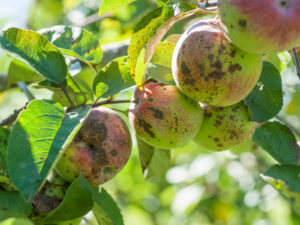
Diseases Management in Apple Fruit
Controlling diseases in apple fruit requires a combination of preventive measures, cultural practices, and, in some cases, the use of appropriate fungicides. Here are some strategies to help control diseases in apple fruit:
1. Plant Disease-Resistant Varieties:
Choose apple varieties that have natural resistance or tolerance to common diseases prevalent in your region. Disease-resistant varieties can help reduce the risk of infection and minimize the need for chemical controls.
2. Orchard Sanitation:
Proper sanitation practices can help prevent disease spread. Remove and destroy fallen leaves, pruned branches, and any infected or mummified fruit from the orchard. This reduces the presence of disease inoculum and minimizes potential sources of infection.
3. Pruning and Thinning:
Regular pruning helps improve airflow and sunlight penetration, reducing conditions favorable for disease development. Thinning fruit clusters promotes better air circulation and reduces the likelihood of fruit touching, which can contribute to disease spread.
4. Water Management:
Avoid over-irrigation and ensure proper drainage to prevent waterlogged conditions that can promote disease development. Water at the base of the tree rather than overhead to minimize prolonged leaf wetness.
5. Fungicide Applications:
In some cases, fungicides may be necessary to control diseases. Consult with local agricultural extension services or professionals to determine the appropriate fungicides and application timing for specific diseases prevalent in your area. Follow the instructions and guidelines for proper and safe use of fungicides.
6. Integrated Pest Management (IPM):
Adopt an integrated approach that combines various cultural, biological, and chemical methods to manage diseases effectively. Integrated Pest Management strategies aim to minimize pesticide use while promoting long-term sustainability and reducing environmental impact.
7. Regular Monitoring:
Monitor the orchard regularly for signs of disease, including fruit lesions, leaf spots, or any unusual symptoms. Early detection allows for timely intervention and more effective disease control. It’s important to note that disease control strategies can vary depending on the specific diseases prevalent in your region and the apple varieties being grown. Local agricultural extension services or professionals can provide tailored guidance and recommendations based on your specific circumstances.
Demond Of Apple Fruit
The demand for apple fruit is consistently high due to its popularity and versatile uses. Here are some factors contributing to the demand for apple fruit:
1. Nutritional Value:
Apples are known for their nutritional value, including being a good source of dietary fiber, antioxidants, and vitamins. The health-conscious population appreciates the nutritional benefits and includes apples in their diets.
2. Versatility in Culinary Uses:
Apples can be consumed fresh, added to salads, used in baking pies, tarts, and cakes, or processed into juices, cider, apple sauce, and other products. The versatility of apples makes them a staple ingredient in many recipes and food products, contributing to their demand.
3. Global Availability:
Apples are grown in various regions worldwide, allowing for a consistent supply throughout the year. This availability makes apples easily accessible to consumers, increasing their demand.
4. Taste and Flavor:
Apples offer a range of tastes and flavors, from sweet to tart, satisfying a wide range of taste preferences. The diversity in apple varieties ensures that consumers can find apples that suit their flavor preferences, further driving demand.
5. Snack Convenience:
Apples are a convenient and portable snack option. They come in individual portions, require no peeling, and are relatively mess-free. This convenience makes apples an appealing choice for on-the-go consumption, boosting their demand as a healthy snack.
6. Marketing and Promotion:
Apple growers and marketers actively promote apples through advertising, branding, and educational campaigns. These efforts create consumer awareness, enhance the perceived value of apples, and stimulate demand.
7. Long Shelf Life:
Apples have a relatively long shelf life compared to many other fruits. Properly stored apples can last for several weeks, making them a preferred choice for consumers seeking fruits with extended freshness.
8. Cultural and Traditional Significance:
Apples hold cultural and traditional significance in various regions, such as being associated with autumn harvest festivals or symbolic meanings in folklore and religious traditions. These cultural connections can influence the demand for apples in specific contexts.
Sells & Export of Apple Fruits
Apple fruits are widely traded and exported globally due to their popularity and demand. Several countries are major producers and exporters of apples. Here are some key aspects of the sales and export of apple fruits:
1. Major Exporting Countries:
The largest exporters of apples include China, the United States, Poland, Italy, and France. These countries have favorable climatic conditions, advanced agricultural practices, and significant apple production capacities.
2. International Trade:
Apples are traded internationally through various channels, including direct exports, import-export companies, and global fruit distribution networks. They are transported via air, sea, and land to reach markets worldwide.
3. Market Destinations:
Apple fruits are exported to a wide range of countries, both neighboring and distant. The major importers of apples include countries such as Germany, the United Kingdom, Russia, Canada, Saudi Arabia, and India. The specific destinations can vary depending on factors such as quality requirements, preferences, market access, and trade agreements.
4. Quality Standards and Certifications:
International trade of apples is subject to quality standards and certifications to ensure safety, quality, and compliance with import regulations. Common certifications include Global GAP (Good Agricultural Practices), HACCP (Hazard Analysis and Critical Control Points), and organic certifications.
5. Packaging and Grading:
Apples are typically packaged in various forms, including bulk containers, cartons, crates, or pre-packaged bags. Grading systems are employed to categorize apples based on size, color, and quality. Standardized packaging and grading help maintain consistency and meet customer requirements.
6. Seasonality:
Apple harvest seasons vary by region, with different countries having different peak seasons. This allows for a year-round supply of apples in the global market, as importing countries can source from different regions depending on the time of year.
7. Marketing and Promotion:
Exporters often engage in marketing and promotional activities to create awareness and increase demand for their apple products. This can include participation in trade fairs, advertising campaigns, and building relationships with importers and distributors.
8. Trade Barriers and Tariffs:
Trade barriers, such as tariffs and non-tariff barriers, can impact the export of apples. Import duties, phytosanitary requirements, and trade disputes can affect the competitiveness and profitability of apple exports.
